The face steamer market is projected to grow from USD 0.7 billion in 2025 to USD 1.3 billion by 2035, reflecting a CAGR of 7.0%. This growth represents an absolute dollar opportunity of USD 0.6 billion over the decade. The market starts at USD 0.5 billion in the earlier years and reaches USD 0.9 billion by 2030, reflecting steady annual increases. For companies in personal care and beauty devices, this trajectory indicates reliable revenue potential.
Aligning product development, distribution, and marketing strategies with the growing demand allows businesses to capture incremental value and establish a strong presence in the expanding face steamer market. The absolute dollar opportunity from 2025 to 2035 highlights incremental growth from USD 0.7 billion to USD 1.3 billion.
Annual gains move from USD 0.7 billion in 2026 to USD 1.2 billion in 2034, before reaching USD 1.3 billion in 2035. This predictable expansion allows companies to plan production, distribution, and promotional strategies effectively. Capturing market share during this period ensures meaningful revenue gains while managing investment risk. Businesses entering or scaling operations in line with these trends can maximize returns and strengthen their position in the evolving face steamer market.
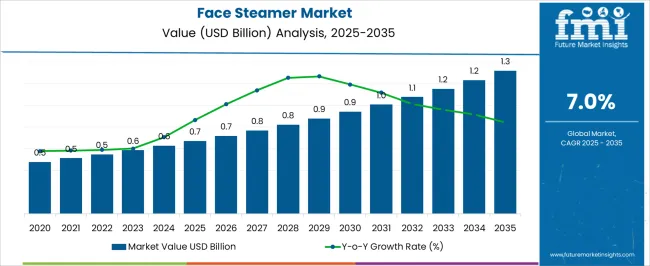
| Metric | Value |
|---|---|
| Face Steamer Market Estimated Value in (2025 E) | USD 0.7 billion |
| Face Steamer Market Forecast Value in (2035 F) | USD 1.3 billion |
| Forecast CAGR (2025 to 2035) | 7.0% |
A breakpoint analysis of the face steamer market highlights periods of gradual and accelerated growth. From 2025 to 2028, the market grows from USD 0.7 billion to USD 0.8 billion, with annual increments of around USD 0.05–0.1 billion. This early-stage period represents a stable phase where companies can establish operations, test distribution channels, and refine product offerings. Recognizing this initial breakpoint allows businesses to allocate resources efficiently and build market presence. Early engagement during this period ensures readiness for stronger growth later, while providing insights into consumer preferences and effective marketing strategies for the expanding face steamer market. The second breakpoint occurs between 2030 and 2035, as the market expands from USD 0.9 billion to USD 1.3 billion, reflecting larger annual increments of USD 0.1–0.2 billion. This stage represents accelerated growth and meaningful absolute dollar opportunity, making strategic positioning essential. Companies entering or scaling operations during this phase can capture substantial revenue gains while strengthening competitive positioning. Understanding these breakpoints helps stakeholders plan investments, production, and marketing strategies to maximize returns in the evolving face steamer market.
The face steamer market is experiencing consistent growth, supported by rising consumer interest in at-home skincare routines and the growing influence of wellness-focused lifestyles. Beauty industry updates and product launch announcements have emphasized the role of facial steaming in deep cleansing, hydration, and improved skin absorption of topical products.
The increasing availability of affordable and portable devices has expanded the user base beyond professional salons to households. E-commerce growth, combined with targeted digital marketing campaigns by beauty brands, has amplified consumer awareness and accessibility of face steamers.
Additionally, demand has been strengthened by seasonal skincare needs, particularly in colder climates where facial hydration becomes a priority. Technological advancements, such as adjustable steam settings and integration of aromatherapy functions, have enhanced product appeal. Looking forward, market expansion is expected to be driven by continued innovation in device features, competitive pricing strategies, and increasing consumer focus on self-care solutions that deliver salon-like results at home.
The face steamer market is segmented by type, price range, end use, distribution channel, and geographic regions. By type, face steamer market is divided into Electric and Battery operated. In terms of price range, face steamer market is classified into Low, Mid, and High. Based on end use, face steamer market is segmented into Individual and Commercial. By distribution channel, face steamer market is segmented into Online and Offline. Regionally, the face steamer industry is classified into North America, Latin America, Western Europe, Eastern Europe, Balkan & Baltic Countries, Russia & Belarus, Central Asia, East Asia, South Asia & Pacific, and the Middle East & Africa.
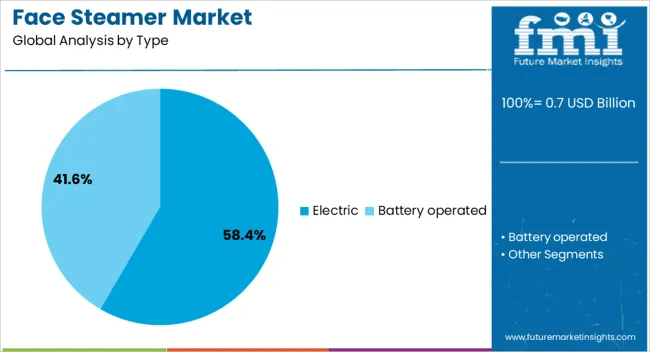
The electric segment is projected to account for 58.4% of the face steamer market revenue in 2025, maintaining its leading position due to its convenience, performance consistency, and adaptability for personal and professional use.
Growth in this segment has been driven by the ability of electric steamers to produce controlled and sustained steam output, allowing for more efficient skincare treatments. Manufacturers have introduced electric models with features such as rapid heat-up times, adjustable steam intensity, and integrated safety mechanisms, which have enhanced user confidence and satisfaction.
The segment has also benefited from the increasing availability of compact and travel-friendly electric units that appeal to urban consumers with busy lifestyles. With ongoing innovations in design and multifunctionality, including the integration of essential oil diffusers and ionized steam technology, the electric segment is expected to remain the preferred choice among consumers seeking reliable and effective facial steaming solutions.
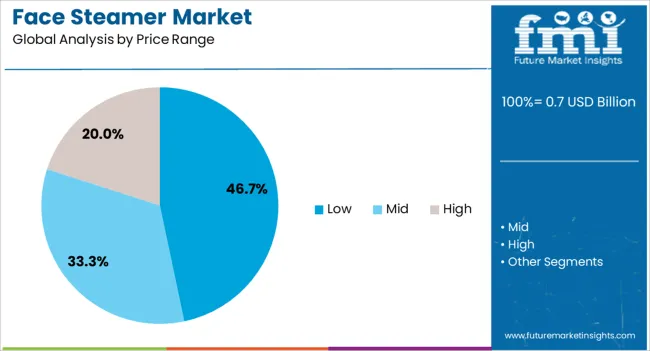
The low price range segment is projected to contribute 46.7% of the face steamer market revenue in 2025, securing its place as the dominant pricing category.
This segment’s growth has been fueled by the affordability of entry-level devices, which has encouraged first-time buyers to adopt facial steaming as part of their skincare regimen. The proliferation of low-cost models through online marketplaces and discount retail channels has widened product accessibility, especially in emerging markets.
Manufacturers have leveraged cost-effective production techniques and simplified product designs to meet consumer demand for budget-friendly skincare devices without compromising basic functionality. Promotional campaigns and seasonal sales events have further boosted sales in this price category, making it an attractive option for consumers seeking value-driven purchases. As beauty brands continue to target price-sensitive customers with competitively priced, functional steamers, the low price range segment is expected to retain its leadership.

The individual segment is projected to hold 64.2% of the face steamer market revenue in 2025, dominating the end-use landscape due to the rising preference for at-home skincare treatments.
This segment has grown as consumers increasingly prioritize convenience, cost savings, and privacy in their beauty routines. Home-use steamers have become popular among individuals seeking to replicate spa experiences without visiting professional salons.
Social media beauty influencers and skincare educators have played a key role in promoting facial steaming as a simple yet effective step in regular skincare maintenance, driving adoption among younger demographics. The availability of user-friendly designs and portable models has further encouraged individual usage. With the trend toward self-care and personal grooming continuing to rise, the individual segment is expected to sustain its leading position, supported by product innovations that cater to diverse skin types and lifestyle needs.
The face steamer market is growing due to rising skincare awareness, increasing adoption of at-home beauty routines, and expansion of professional spa services. North America and Europe lead in demand for advanced, multifunctional steamers with features like aromatherapy, LED therapy, and ozone sterilization. Asia-Pacific shows rapid growth driven by rising disposable incomes, beauty-conscious consumers, and e-commerce penetration. Key manufacturers differentiate through device performance, safety features, and compact designs. Market expansion is fueled by consumer focus on skincare health, facial cleansing, and rejuvenation, as well as growing interest in DIY facial treatments and home-based beauty technologies.
Face steamers differ in heating mechanism, steam output, and multifunctionality. Europe and North America favor premium devices with precise temperature control, ozone sterilization, and dual-mode operation for home and professional use. Asia-Pacific consumers often adopt cost-efficient, single-function devices for personal use. Differences in technology affect performance, user safety, and consumer satisfaction. Leading global suppliers provide high-performance, certified devices, while regional producers focus on affordability and volume sales. These contrasts shape adoption, pricing strategies, and brand preference across professional and consumer segments in different regions.
Ergonomic design, device size, and portability influence usability. European and North American markets prioritize compact, user-friendly, and aesthetically appealing devices for convenience and prolonged use. Asia-Pacific buyers often prefer larger, simpler models optimized for cost-sensitive home users. Differences in design and ergonomics impact ease of use, storage, and consumer experience. Manufacturers offering portable, stylish, and safe devices capture premium buyers, whereas regional producers target volume-oriented markets. Variations in design directly influence market adoption, brand loyalty, and competitiveness across professional, retail, and home-use segments.
Face steamer sales rely on retail and online distribution. North America and Europe emphasize e-commerce platforms, specialty beauty stores, and professional spa partnerships. Asia-Pacific adoption is driven by mass-market retail, online marketplaces, and direct-to-consumer channels. Differences in channel strategy impact accessibility, pricing, and brand visibility. Global suppliers leverage multi-channel approaches for maximum reach, while smaller regional manufacturers rely on local distribution. Distribution contrasts influence adoption speed, consumer awareness, and long-term growth potential in mature and emerging markets.
Regional demand is shaped by awareness of skincare benefits and wellness routines. Europe and North America focus on multifunctional devices for anti-aging, facial cleansing, and relaxation. Asia-Pacific consumers are increasingly adopting devices for acne treatment, hydration, and home beauty care. Differences in consumer priorities influence product features, marketing strategies, and regional adoption. Leading suppliers tailor products to meet diverse skincare needs, while regional manufacturers provide basic, cost-efficient options. Understanding these contrasts enables companies to optimize product development, marketing campaigns, and regional penetration strategies, capturing both premium and mass-market segments effectively.
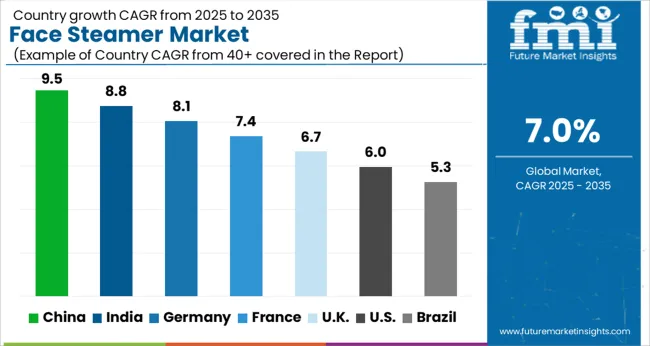
| Country | CAGR |
|---|---|
| China | 9.5% |
| India | 8.8% |
| Germany | 8.1% |
| France | 7.4% |
| UK | 6.7% |
| USA | 6.0% |
| Brazil | 5.3% |
The global face steamer market was projected to grow at a 7.0% CAGR through 2035, driven by demand in personal care, beauty, and skincare applications. Among BRICS nations, China recorded 9.5% growth as large-scale manufacturing facilities were commissioned and compliance with product quality and safety standards was enforced, while India at 8.8% growth saw expansion of production units to meet rising regional consumer demand. In the OECD region, Germany at 8.1% maintained substantial output under strict cosmetic and electrical regulations, while the United Kingdom at 6.7% relied on moderate-scale operations for personal care and beauty applications. The USA, expanding at 6.0%, remained a mature market with steady demand in home and professional skincare segments, supported by adherence to federal and state-level safety and quality standards. This report includes insights on 40+ countries; the top five markets are shown here for reference.
Face steamer market in China is growing at a CAGR of 9.5%. Between 2020 and 2024, growth was driven by rising disposable income, increasing skincare awareness, and expansion of beauty and personal care retail channels. Manufacturers focused on high performance, user-friendly, and multi-functional steamers for home and professional use. In the forecast period 2025 to 2035, growth is expected to accelerate with adoption of smart, portable, and energy efficient devices. Rising e-commerce penetration, skincare trends, and demand for wellness and beauty treatments will further support market expansion. China remains a leading market due to large consumer base, rapid urbanization, and growing beauty industry.
Face steamer market in India is growing at a CAGR of 8.8%. Historical period 2020 to 2024 saw growth supported by increasing consumer focus on personal grooming, home spa treatments, and expansion of beauty retail channels. Manufacturers focused on compact, cost-effective, and easy-to-use devices. In the forecast period 2025 to 2035, market growth is expected to continue with adoption of smart, portable, and multifunctional steamers. Rising disposable income, urban lifestyle trends, and e-commerce sales will further drive growth. India is projected to maintain strong growth due to growing interest in personal care and wellness products.
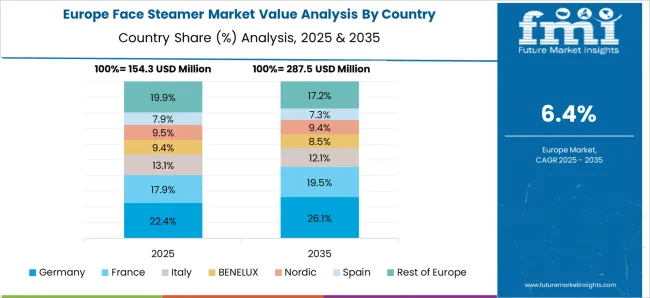
Face steamer market in Germany is growing at a CAGR of 8.1%. Between 2020 and 2024, growth was supported by increasing focus on skincare, wellness treatments, and premium personal care products. Manufacturers focused on energy efficient, safe, and high performance devices. In the forecast period 2025 to 2035, market growth is expected to continue steadily with adoption of smart, portable, and multifunctional steamers. Sustainability, technological innovation, and rising consumer preference for home wellness solutions will further support adoption. Germany remains a key European market due to high skincare awareness and strong wellness industry.
Face steamer market in the United Kingdom is growing at a CAGR of 6.7%. During 2020 to 2024, adoption was driven by home beauty treatments, increasing skincare routines, and retail availability of compact steamers. Manufacturers focused on reliable, user-friendly, and portable devices. In the forecast period 2025 to 2035, market growth is expected to continue moderately with adoption of multifunctional, energy efficient, and smart face steamers. Rising awareness of personal wellness and e-commerce penetration will further support market expansion. The United Kingdom market reflects stable growth with emphasis on convenience, performance, and affordability.
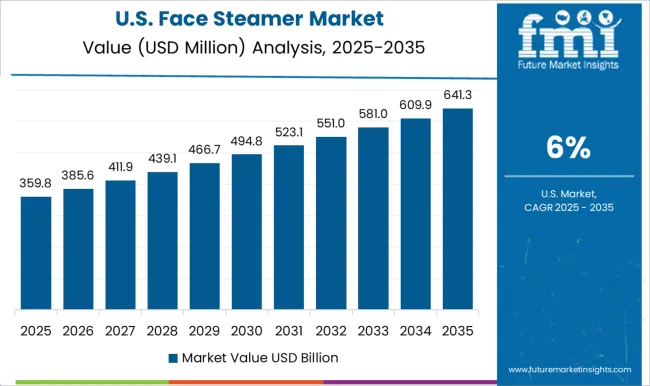
Face steamer market in the United States is growing at a CAGR of 6.0%. Historical period 2020 to 2024 saw growth driven by rising skincare routines, home spa trends, and retail availability through online and offline channels. Manufacturers focused on high performance, safe, and portable devices. In the forecast period 2025 to 2035, growth is expected to continue steadily with adoption of smart, multifunctional, and energy efficient steamers. Rising consumer focus on wellness, beauty, and skincare solutions will further support expansion. The United States market demonstrates steady growth with emphasis on convenience, safety, and technological innovation.
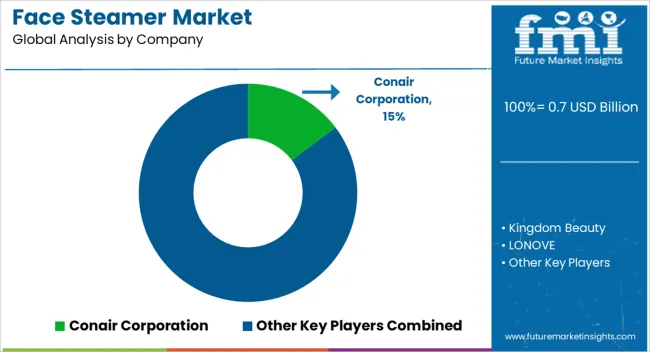
The face steamer market is supplied by Conair Corporation, Kingdom Beauty, LONOVE, Panasonic Corporation, Pure Daily Care, Revlon Inc., Secura, SENNEN, Vanity Planet, and Zorra. Competition is primarily driven by product performance, portability, and design versatility. Conair and Panasonic brochures highlight tabletop steamers with adjustable steam output, nano-ionic technology, and detachable water reservoirs. Revlon and Vanity Planet datasheets detail dual-purpose steamers featuring facial masks, aromatherapy adapters, and automatic shut-off features.
Kingdom Beauty and Pure Daily Care focus on compact, travel-friendly designs, specifying power consumption, steam time, and safety certifications. Observed industry patterns indicate growing demand for multifunctional and home-spa devices that integrate skincare convenience with ergonomic designs. Market strategies emphasize differentiation, direct-to-consumer sales, and value-added features. Conair and Panasonic prioritize high-efficiency heating elements and consistent steam flow for deep pore cleansing.
Revlon, Vanity Planet, and Secura leverage brand recognition, retail partnerships, and bundled skincare solutions to attract consumers. LONOVE and SENNEN target mid-range segments with affordability and user-friendly features. Observed strategies include expanding online presence, emphasizing product warranties, and providing usage guides to boost consumer confidence. Pure Daily Care and Zorra highlight minimalist design, low maintenance, and portability, aiming at urban households and travel enthusiasts. Across suppliers, emphasis is placed on meeting international safety standards, energy efficiency, and ease of cleaning, with frequent updates to product lines to align with seasonal skincare trends.
Product brochures and technical datasheets convey specifications including water tank capacity, runtime, heat-up duration, steam temperature, power rating, and accessory compatibility. Conair and Panasonic include diagrams for optimal usage distance, skin sensitivity settings, and maintenance instructions. Revlon and Vanity Planet emphasize multiple functional modes, aromatherapy compatibility, and included facial treatment accessories.
LONOVE and SENNEN provide guides for cleaning, storage, and troubleshooting, while Pure Daily Care and Zorra highlight compactness and portability for travel use. Clear documentation supports consumers, dermatologists, and wellness professionals in selecting products based on verified steaming efficiency, safety features, and functional versatility, ensuring suitability across home, travel, and professional facial care applications.
| Item | Value |
|---|---|
| Quantitative Units | USD 0.7 Billion |
| Type | Electric and Battery operated |
| Price Range | Low, Mid, and High |
| End Use | Individual and Commercial |
| Distribution Channel | Online and Offline |
| Regions Covered | North America, Europe, Asia-Pacific, Latin America, Middle East & Africa |
| Country Covered | United States, Canada, Germany, France, United Kingdom, China, Japan, India, Brazil, South Africa |
| Key Companies Profiled | Conair Corporation, Kingdom Beauty, LONOVE, Panasonic Corporation, Pure Daily Care, Revlon Inc., Secura, SENNEN, Vanity Planet, and Zorra |
| Additional Attributes | Dollar sales vary by product type, including handheld, tabletop, and professional facial steamers; by application, such as skincare, spa treatments, and home beauty care; by end-use industry, spanning personal care, wellness, and beauty salons; by region, led by North America, Europe, and Asia-Pacific. Growth is driven by rising skincare awareness, home beauty trends, and demand for spa-like experiences. |
The global face steamer market is estimated to be valued at USD 0.7 billion in 2025.
The market size for the face steamer market is projected to reach USD 1.3 billion by 2035.
The face steamer market is expected to grow at a 7.0% CAGR between 2025 and 2035.
The key product types in face steamer market are electric and battery operated.
In terms of price range, low segment to command 46.7% share in the face steamer market in 2025.






Full Research Suite comprises of:
Market outlook & trends analysis
Interviews & case studies
Strategic recommendations
Vendor profiles & capabilities analysis
5-year forecasts
8 regions and 60+ country-level data splits
Market segment data splits
12 months of continuous data updates
DELIVERED AS:
PDF EXCEL ONLINE
Face and Ear Bows Market Size and Share Forecast Outlook 2025 to 2035
Face Paper Market Analysis - Size, Share, and Forecast Outlook 2025 to 2035
Face Shield Market
Face Mask Device Market
Surface Protection Film Market Forecast and Outlook 2025 to 2035
Surface printed Film Market Size and Share Forecast Outlook 2025 to 2035
Surface Treatment Chemicals Market Size and Share Forecast Outlook 2025 to 2035
Surface Mounting Distribution Panel Market Size and Share Forecast Outlook 2025 to 2035
Surface Mounted Medium Voltage Distribution Panel Market Size and Share Forecast Outlook 2025 to 2035
Surface Radars Market Size and Share Forecast Outlook 2025 to 2035
Surface Mining Market Size and Share Forecast Outlook 2025 to 2035
Surface Mount Technology Market Size and Share Forecast Outlook 2025 to 2035
Surface Levelling Equipment Market Size and Share Forecast Outlook 2025 to 2035
Surface Mining Equipment Market Size and Share Forecast Outlook 2025 to 2035
Surface Disinfectant Chemicals Market Growth & Demand 2025 to 2035
Surface Disinfectant Market is segmented by product type, form and end user from 2025 to 2035
Surface Disinfectant Products Market Growth - Trends and Forecast 2025 to 2035
Competitive Overview of Surface Printed Film Companies
Surface Water Sports Equipment Market Growth – Size, Trends & Forecast 2024-2034
Surface Plasmon Resonance System Market Analysis – Growth & Forecast 2024-2034

Thank you!
You will receive an email from our Business Development Manager. Please be sure to check your SPAM/JUNK folder too.
Chat With
MaRIA